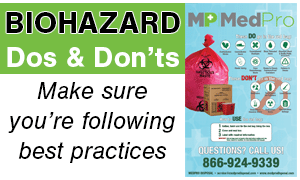Every doctor’s office accumulates medical waste. Therefore, it’s important to know how to prepare these materials to be shipped for disposal. Depending on your state, the regulations on how to properly prepare medical waste can vary. However, most states have developed detailed rules to control the way this type of waste is managed on-site.
If you want medical items to be treated for disposal off-site, most states require that the waste be made non-infectious prior to its elimination. This procedure can be done on-site or at a permitted treatment facility. It’s important to note that throughout the nation, permitted locations have very strict standards which must be met.
Registration or Permits
In some states, healthcare facilities need to register in order to be recognized as a medical waste generator. Certain states ask for a “generator identification number.” This is similar to the RCRA (Resource Conservation and Recovery Act) hazardous waste ID number that a handful of states require.
Whether a facility has a large or small amount of medical waste can also make a difference in the conditions that must be met for registration or permits. Smaller facilities may not face stringent demands based on the state’s applicable rules.
Find Out How Much You Can Save Instantly.
Try our on-line savings calculator.
Other states don’t factor size into the equation. Instead, they obligate healthcare facilities to produce a plan that guarantees the appropriate management of RMW (regulated medical waste). Sometimes this prerequisite can be satisfied simply by meeting the provisions outlined in the OSHA (Occupational Safety and Health Administration) Bloodborne Pathogen Standard.
Waste Segregation
No matter where your practice is located, it’s always best to separate RMW from general waste. Taking this route is highly recommended because of the expenses associated with both the management and disposal of RMW as opposed to general solid waste.
Certain states don’t give healthcare facilities an option about segregating their waste. It’s just required by law. Other states simply recommend this step in the RMW preparation process.
Packaging and Labeling
Definitive rules for packaging and labeling RMW differ by state. In general, however, every guideline is designed to contain waste safely during storage and transport. Furthermore, these laws are meant to protect employees and the public from potential hazards.
Although each state has its own variations, most packaging rules include:
- Containers – Sharps disposal must be placed in rigid, leak-resistant, puncture-resistant containers that are tightly secured to prevent the loss of any contents. All other infectious waste needs to be placed, stored and maintained before and during transport in rigid, leak-proof containers that are immune to moisture. Containers must be strong enough to prevent bursting and tearing during handling, storage or transportation as well. Also, this waste should be contained in disposable or reusable containers that are suitable for the specific type and quantity of materials. Furthermore, they should be made well enough to survive handling, transfer and transportation without damaging the container, closed tightly and be compatible with selected storage, transportation and treatment processes.
- Plastic bags – Any plastic bags used inside containers must be either red or orange and made of material that prevents tearing.
Most states typically allow reusable containers. They only need to be disinfected after each use. Also, the majority of states do not allow containers to be compacted.
For purposes of labeling, it’s usually required that containers with infectious waste have the words: “Infectious Waste” written on them. The biohazard symbol must be clearly placed on these containers, too. Some states also want the name of the generation facility, contact information and the destination facility included on the label.
Storage
Although experts advise RMW to be treated as quickly as possible, it’s often difficult to bypass temporary storage. To adjust for this reality, certain states offer guidelines for storage areas and time limits. For the most part, states don’t require permits to store RMW.
However, each state has its own rules regarding storage. The most common regulations include:
- RMW must be separated from regular waste in a designated area and clearly labeled with the universal warning sign or the word: “Biohazard.”
- The storage area has to be ventilated and in a place that minimizes access by the general public and is only available to authorized personnel.
- Many states do not provide strict time limits for RMW storage while a select few are more exacting about how long this waste can be stored. But it is typical for a state to require the waste to be maintained in a nonputrescent state and using refrigeration when needed. Plus, vermin and insects must be controlled. When storage time limits are in place, they usually range from 7 to 90 days.
One Final Note
As you can tell, state laws for the disposal of RMW have many variations. Therefore, it’s important that you check your state regulations before handling medical waste so that you adhere to any specific guidelines.



